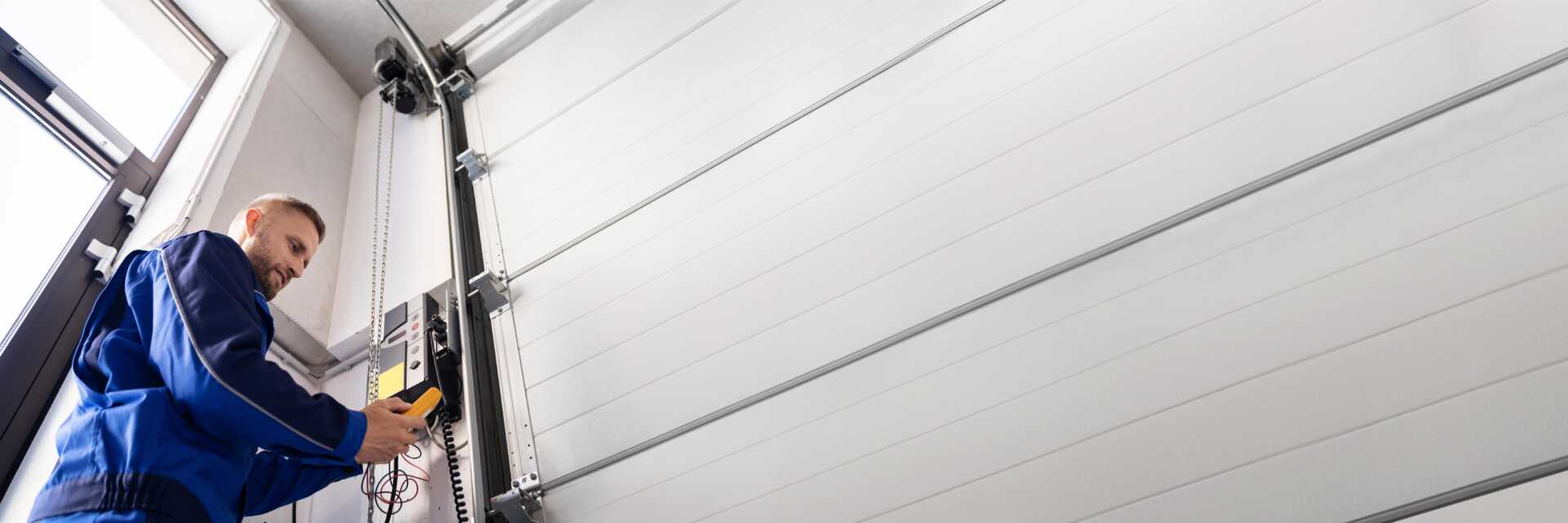
Contents
When it’s time to replace your garage door opener, knowing where to start can make the process smoother. You’ll want to assess your current opener’s condition first and think about the right type for your needs. Taking accurate measurements of your garage door is vital for compatibility. But there’s more to evaluate before making your purchase. Let’s explore the essential steps that will ensure a successful installation.
Key Takeaways
- Assess your current garage door opener’s lifespan, usage, and maintenance history to determine if replacement is necessary.
- Choose the right type of garage door opener (belt, chain, screw drive) based on noise levels and safety features.
- Measure your garage door accurately to ensure compatibility with the new opener, considering height, width, and weight.
- Follow the manufacturer’s installation instructions carefully, using a level for alignment and ensuring safety precautions are taken.
- Regularly maintain the new opener by lubricating moving parts and checking safety sensors to prolong its lifespan and performance.
Assessing Your Current Garage Door Opener
Have you ever wondered if your garage door opener is still doing its job effectively? Evaluating its performance can save you time and money.
First, consider the opener lifespan factors: age, frequency of use, and maintenance history. Most openers last about 10-15 years, so if yours is nearing that mark, it’s time to assess.
Next, run through some opener troubleshooting tips. Listen for unusual noises during operation; grinding or squeaking could indicate wear.
Check the sensors for proper alignment and verify they’re free of obstructions. If the opener struggles to lift the door or operates intermittently, it might signal a need for repair or replacement.
Choosing the Right Type of Garage Door Opener
When selecting a garage door opener, it’s crucial to understand the different types available and how they fit your needs.
Consider factors like power and speed to ensure you choose a model that operates smoothly and efficiently.
This decision can greatly impact your garage’s functionality and security.
Opener Types Overview
Choosing the right garage door opener can markedly enhance your home’s convenience and security. There are several types to take into account, each with unique features that align with your needs.
Belt Drive: Quiet and smooth operation, ideal for attached garages.
Chain Drive: Durable and cost-effective, but can be noisier.
Screw Drive: Low maintenance, but installation costs can vary.
Additionally, smart openers offer advanced security features, letting you control access remotely.
When selecting, think about noise levels, installation costs, and warranty options to ensure you make a smart investment.
Prioritize safety features to keep you and your family secure.
Power and Speed Considerations
While selecting the right garage door opener, understanding power and speed specifications is essential for ideal performance.
First, consider the power ratings, which directly affect the opener’s ability to lift heavy doors efficiently. A higher power rating is beneficial for larger, heavier doors, ensuring smooth operation without straining the motor.
Next, evaluate the speed settings. Some openers offer adjustable speeds, allowing you to control how quickly your door opens or closes.
Faster settings can be convenient for busy households, while slower speeds might enhance safety, especially for children and pets.
Measuring Your Garage Door for Compatibility
Before purchasing a garage door opener, you need to measure your door to ensure compatibility.
Consider the size of your door, as this will influence the type of opener you’ll need.
Matching the right opener type to your door’s dimensions is essential for peak performance and security.
Door Size Considerations
When you’re ready to install a garage door opener, it’s crucial to measure your door accurately to ensure compatibility.
Start by noting the door height and ensuring it’s within the opener’s specifications. Additionally, consider the door’s weight capacity, as this will affect the type of opener you choose.
Here are some key measurements to take:
- Height: Measure the total height from the ground to the top of the door.
- Width: Record the width at its widest point.
- Weight: If possible, weigh the door or check the manufacturer’s specifications.
These measurements will help you select an opener that fits your garage door perfectly, ensuring safe and efficient operation.
You’ll feel confident knowing you made the right choice!
Opener Type Match
To ensure your garage door opener matches your door type, you need to understand the various opener styles available and how they correspond to your specific door.
Start with an opener compatibility check, ensuring the type—chain, belt, or screw—is suited for your door’s weight and size. Each style offers different advantages, like noise levels and speed.
If you’re interested in modern technology, look for models with smart opener features that allow remote access and monitoring through your smartphone. This way, you can control your garage door from anywhere, adding convenience to your daily routine.
Gathering Necessary Tools and Materials
Gathering the right tools and materials is essential for a smooth garage door opener installation. To set yourself up for success, create a tool checklist and gather all material essentials before you start. This way, you won’t have to pause mid-project to hunt for what you need.
Here’s a simple list to help you get organized:
- Tools: Screwdriver, wrench, and level
- Materials: New garage door opener, mounting hardware, and safety cables
- Safety Gear: Gloves, safety glasses, and a sturdy ladder
Having these items ready ensures a seamless installation experience, making you feel accomplished and confident in your DIY skills.
Remember, preparation is key! By checking off your list, you’re saving time and creating a safer work environment.
Safely Disconnecting the Existing Opener
Before you start removing the existing garage door opener, it’s crucial to ensure safety first. Begin by unplugging the opener from the power source to avoid any electrical hazards. Use proper safety precautions like wearing gloves and goggles. Confirm the garage door is fully closed and secured before proceeding.
Here are some disconnecting techniques to follow:
| Step | Action |
|---|---|
| 1. Power Off | Unplug the garage door opener. |
| 2. Secure Door | Confirm the door is closed. |
| 3. Disconnect Rails | Remove the rail from the opener. |
| 4. Detach Wiring | Carefully disconnect the wires. |
Installing the New Garage Door Opener
Installing a new garage door opener can greatly enhance your home’s convenience and security. To ensure a smooth installation process, follow these essential installation tips and remember to take safety precautions.
- Read the manufacturer’s instructions thoroughly before starting.
- Use a level to ensure proper alignment of the opener.
- Double-check all connections and settings before powering it up.
Before you begin, gather all necessary tools and materials. Make sure the area is clear of obstacles, and don’t hesitate to ask a friend for help—two pairs of hands are often better than one.
As you work, keep safety in mind by wearing protective gear and ensuring that the garage door is disconnected from the opener. By following these steps, you’ll install your new opener correctly and feel a sense of accomplishment and belonging in your home improvement journey.
Connecting the Power and Testing Functionality
Once you’ve completed the installation of your garage door opener, it’s time to connect the power and test its functionality. Start by ensuring that the power connection is secure. Plug the opener into a grounded outlet, avoiding extension cords if possible. Double-check that all wiring is intact and properly connected.
Next, perform functionality testing by following these steps:
| Step | Action | Result |
|---|---|---|
| Step 1 | Press the wall button | Door should open/close smoothly |
| Step 2 | Use the remote (if applicable) | Remote should operate the door |
| Step 3 | Observe the safety sensors | Sensors should prevent closing if obstructed |
| Step 4 | Listen for unusual sounds | No grinding or squeaking sounds |
If everything operates as it should, you’re well on your way to enjoying seamless garage access!
Programming Remote Controls and Keypads
Programming your remote controls and keypads is a straightforward process that enhances your garage door opener’s convenience and security.
By following a few simple steps, you’ll ensure easy access for you and your family.
Here’s how to get started:
Remote Programming: Press and hold the “learn” button on your garage door opener until the indicator light turns on. Then, press the button on your remote until the light blinks, confirming successful programming.
Keypad Setup: Enter your chosen PIN on the keypad and press the “enter” button. Follow the manufacturer’s instructions for specific models, as steps can vary.
Testing: Always test both the remote and keypad to ensure they work properly.
Performing Routine Maintenance Post-Installation
After setting up your remote controls and keypads, it’s important to focus on maintaining your garage door opener for peak performance. Performing routine checks can help you spot issues before they escalate.
Start by inspecting the door’s tracks and rollers for debris or damage; clean them as needed. Test the safety sensors to verify they’re functioning correctly—this is crucial for your family’s safety.
Establish a lubrication schedule, applying a silicone-based lubricant to the moving parts every six months. This keeps everything running smoothly and extends the life of your opener.
Don’t forget to examine the opener’s drive belt or chain for wear and tear, adjusting it if necessary. By staying proactive with these maintenance tasks, you’ll enhance your garage door opener’s reliability and enjoy peace of mind knowing it’s working as it should.
Regular attention fosters a sense of belonging to a community that values safety and efficiency.
Troubleshooting Common Issues After Replacement
After replacing your garage door opener, you might encounter some common issues, like remote control malfunctions or noisy operation.
If your remote isn’t working, check the batteries and confirm it’s properly programmed.
For noisy operation, inspect the hardware and lubricate moving parts to ensure smooth functioning.
Remote Control Malfunctions
Many homeowners encounter remote control malfunctions shortly after replacing their garage door openers. If you’re facing issues, don’t worry—troubleshooting is often straightforward.
Start by checking these common problems:
Remote battery replacement: A dead battery is often the simplest fix. Replace it and test the remote again.
Interference: Other electronic devices can interfere with your remote signal. Try moving away from appliances or using a different frequency.
Reprogramming: Sometimes, the remote needs reprogramming after installation. Consult your manual for specific instructions.
Noisy Operation Issues
If your garage door opener is functioning correctly, but you notice it’s making unusual noises during operation, you’re not alone. Many homeowners face this issue. To achieve noise reduction, start with lubrication techniques. Regularly apply a silicone-based lubricant to the moving parts, including rollers and hinges.
Here’s a quick reference table for troubleshooting:
| Issue | Solution |
|---|---|
| Grinding noise | Inspect gears; lubricate them |
| Squeaking sounds | Apply lubricant to hinges |
| Rattling components | Tighten screws and bolts |
| Excessive vibration | Check for uneven tracks |
Summary
By following these steps, you’ll ensure a smooth garage door opener replacement. Assess your current opener, choose the right type, measure accurately, and gather your tools. Disconnect safely, connect power, and test functionality. Program remotes and keypads, then maintain routinely. With each action, you’ll create a seamless shift, transforming your garage’s accessibility and safety. Embrace the journey of improvement and enjoy the convenience of a well-functioning opener for years to come.
Recent Posts
3 Best Tips for Troubleshooting Garage Door Repairs
When your garage door isn’t functioning correctly, it can be frustrating and inconvenient. By focusing
Ultimate Guide to Residential Overhead Door Installation
When it comes to residential overhead door installation, making the right choices from the start
5 Expert Tips for Installing Residential Garage Doors
Installing a residential garage door might seem simple, but even small mistakes can lead to

